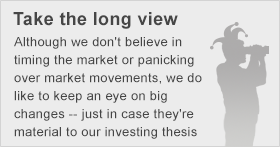
The Dow Jones Industrials (DJINDICES: ^DJI) didn't manage to set a new all-time record high last week, but the stock market has performed extremely well, both in the recent past and ever since the depths of the financial crisis in early 2009. Given how far the Dow has soared in just over five years, many expect a crash to come eventually, and some believe that it could come sooner rather than later. Yet there's a critical factor in determining the timing of the next stock market plunge that market participants are struggling with, because there are conflicting signs of whether share prices in the Dow Jones Industrials and the S&P 500 (SNPINDEX: ^GSPC) have gotten too expensive. The single X factor that is creating the most uncertainty is whether the financial crisis was a one-off aberration or a part of a natural business cycle that investors should take into account.

The CAPE debate
At issue is one of the simplest yet often misunderstood measures of stock market valuation: the price-to-earnings ratio. Many investors look at how share prices compare to the earnings of the businesses that underlie those stocks to determine whether a given stock is valued too highly or too lowly. Earnings multiples that are too high are often the precursor to major Dow crashes, while low earnings multiples tend to precede big bull-market moves that produce unusually strong returns.
By itself, the P/E ratio gives only a one-time snapshot at market valuation, based on a very short timeframe. With corporate earnings having climbed substantially since the Great Recession, P/E ratios based on estimates of future earnings over the past 12 months are still at relatively normal levels. Those figures suggest that even after the massive run-up in the Dow Jones Industrials and the S&P 500 over the past five years, the stock market could have further to rise before getting truly expensive, let alone setting itself up for a big crash.
But by another measure, the Dow and the S&P 500 are already on the expensive side. The cyclically adjusted P/E ratio, or CAPE, goes back more than 12 months in looking at earnings, instead taking an average over the past 10 years to include entire business cycles. When you expand your time horizon to include the negative earnings during the financial crisis, then the average earnings fall dramatically, and that pushes the cyclically adjusted P/E ratio much higher than the forward P/E, with the current CAPE level on the S&P 500 being roughly 25. In the past, the CAPE has gone higher than that, but future returns even from current levels tend to be well below the long-term average.
Looking at alternatives
The other thing to keep in mind is that past crashes have tended to occur at times when interest rates were much higher, making safer investments like Treasuries look more attractive. In late 1987, Treasury bonds offered rates of more than 9%. That meant that any P/E ratio above 11 for the Dow Jones Industrials had to be based on the growth potential of stocks -- growth that was already taxed by high valuations. Now, though, with bonds paying 2.5%, stock valuations can be much higher before bonds look attractive by comparison.
At some point, the Dow Jones Industrials and the S&P 500 will start to decline, whether in a cataclysmic crash or in a longer bear market. Market participants need to decide whether they think the financial crisis was an aberration -- in which case they should look at forward earnings multiples -- or something they must consider -- in which case they should focus on the CAPE. Until they do, it'll be impossible to predict when the Dow might rise so high that a crash becomes unavoidable.
